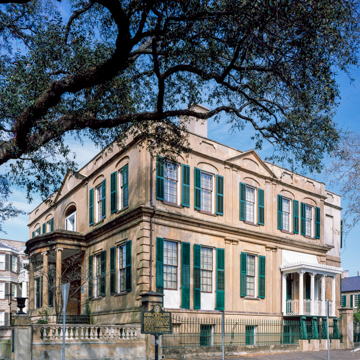You are here
Owens-Thomas House
One of Savannah's most significant buildings, this house reflects the rapid expansion of the city's fortunes during the early nineteenth century. Wealthy banker and shipping merchant Richardson commissioned young English immigrant architect William Jay to design the mansion and accompanying carriage house at the rear. The design reflects a creative adaptation of the neoclassical forms of British architects Sir John Soane and John Nash, which is often called the Regency style. Sited prominently on a trust lot, the central-hall-plan house sits back from the street in a gesture of wealth and status, allowing the elegant and gently bowing one-story portico and reflecting curving staircases to form a sculptural composition that contrasts with the flat simplicity of the rest of the facade. Jay made extensive use of English building materials and technology, including the remarkable one-story cast-iron portico extending from the south elevation that is one of the first uses of structural cast iron in America, as well as gravity-fed plumbing, supplied by cisterns in the attic and basement, which included flush toilets—among the earliest in the country. For the main structure he used the regional building tradition of walls constructed of tabby (a mixture of lime, sand, water, and crushed oyster shells) on the basement and first floors and coquina (a sedimentary rock comprising shells) on the second floor. Inside, elegant neoclassical details are complemented by experimental indirect lighting in the dining room and a dramatic central staircase that includes a bridge on the second floor. The carriage house is the best-preserved slave quarters in Savannah and retains extensive traces of rare "haint blue" paint on its ceilings, a color believed to ward away evil spirits in African traditions. The original work yard was redesigned as a parterre garden in the Regency Manner (1820 A.D.) by Savannah landscape architect Clermont Lee in 1954, when the main floor of the house opened as a museum; Lee revised the garden plan in 1959. The house is believed to have had such a garden on a residential lot across State Street to the north. Public access to other parts of the house came later, with the basement in 1958, the upstairs in 1977, the carriage house in 1998, and the butler's pantry in 2014.
Writing Credits
If SAH Archipedia has been useful to you, please consider supporting it.
SAH Archipedia tells the story of the United States through its buildings, landscapes, and cities. This freely available resource empowers the public with authoritative knowledge that deepens their understanding and appreciation of the built environment. But the Society of Architectural Historians, which created SAH Archipedia with University of Virginia Press, needs your support to maintain the high-caliber research, writing, photography, cartography, editing, design, and programming that make SAH Archipedia a trusted online resource available to all who value the history of place, heritage tourism, and learning.














